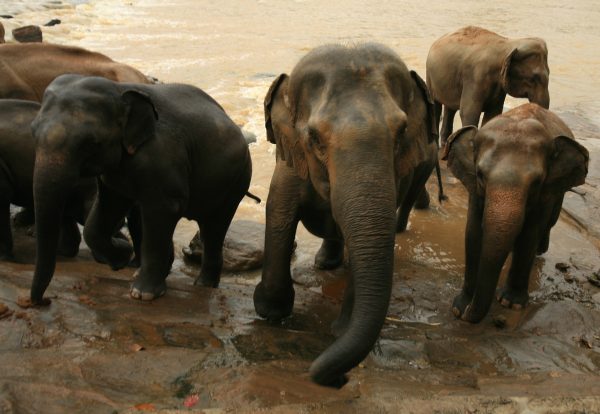Have you ever wondered if an elephant can swim? Or what it eats? Could you lift a baby elephant? Read on to discover 10 amazing facts about this beautiful animal.

1. Elephants are fantastic at swimming
Despite their size, elephants are great swimmers! They keep their heads above water, and use all four legs to swim. Elephants can walk up to 80 miles a day, searching for food and water, resulting in strong and powerful leg muscles. This helps them to swim for long periods of time. The trunk can also be used as a snorkel!
2. Elephants are the largest land animals
An elephant can weigh between four and six tons, which is the weight of four or six small cars!
3. Elephants are vegetarians
An elephant’s diet mostly consists of leaves, bark, roots, grass, flowers, shrubs, bushes and twigs. They do not eat, or hunt for meat. As they have such large bodies, they need to consume a lot of food for fuel, and as a result spend much of their day grazing for food.
4. Their trunks have many uses
The long trunk is an elephant’s most important limb, and has many interesting uses. It is sensitive enough to pick up tiny things, such as a blade of grass, but strong enough to rip branches from tree’s. An elephant also uses it’s trunk for drinking, it can suck up to 14 litres of water (that’s roughly the same amount as 42 cans of fizzy drink!), then blow it straight into its mouth. To protect their skin during the hot weather, elephants use their trunks to spray water over their bodies, and then add a mixture of mud and dirt. This will dry in the sun and act as suntan lotion.
5. Elephants are very kind natured
Elephants care for the other members in their group; they even give each other hugs by wrapping their trunks around one and other. They stroke each other using their trunks, and will work together to help the younger calves if they are in trouble.
6. Girls only club
Generally, large elephant groups are made up of female relatives. The eldest female is usually the leader, also known as the matriarch. She would be the grandmother of the group, followed by daughters, mothers, sisters and aunties. Male elephants prefer to live on their own and leave the herd as they get older.
7. An elephant calf can weigh as much as 33 human babies
A newborn baby elephant can weigh up to 260 pounds. To put this in perspective, a newborn human baby generally weighs an average of 8 pounds. This is the equivalent weight of nearly 33 human babies! The calf can stand up shortly after being born, whereas a human baby starts walking around the age of one.
8. Elephants are able to communicate with each other
Although elephants are not able to effectively ‘talk’ with each other using words like humans can, they are able to communicate in other ways. In the same way humans use body language to convey messages without speaking (such as changing the shape of your mouth to show a ‘sad face’ or frowning if angry); elephants can use non vocal calls to pass on information. For example, when a group of elephants pass each other, members of the group often touch and smell each other in a friendly, non-threatening way with their trunks. The most common form of communication in groups is vocal, that means noises or sounds. These sounds can convey different messages, depending on the pitch and tone. For example, if an elephant issues a loud, urgent, repetitive ‘scream’, it could be signalling danger to the rest of the herd. Most of the noises elephants use are so low, that humans are unable to detect them.
9. Elephants can live for many years
Elephants generally live up to 60 or 70 years old, however, the oldest known elephant reached a grand old age of 86 years! Of course, this all depends on how the elephant has lived, and if they have had a good quality of life.
10. Elephants have amazing long-term memories
Scientists have studied the behaviour of elephants and found that the matriarchs of the group will lead the herd to safety in times of drought (when drinking water is limited) and return to places they haven’t visited in years in search of water.
Sources:
https://www.worldwildlife.org/species/elephant
https://www.nationalgeographic.com/animals/mammals/a/african-elephant/
http://www.discoverwildlife.com/animals/mammals/facts-about-elephants
https://www.elephantsforever.co.za/elephant-communication.html
http://www.wildanimalpark.org/answers/mammals/elephants/




By IP Factly -, thanks a lot for the article post.Much thanks again. Fantastic.